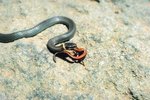
Nevada is home to many snake species due to its variety of climates. Some parts are arid, like the Great Basin desert; others have moist conditions, like Lake Tahoe. Nevada has both venomous and nonpoisonous snakes who use different techniques to subdue their prey and scare enemies.
Garter Snakes
Garter snakes, commonly known as striped garden snakes, are swift-moving snakes found in humid habitats in North America. The four Nevada species of the garter snake are the western terrestrial (Thamnophis elegans), the common (T. sirtalis), the Sierra (T. couchii) and the Mexican (T. eques). Garter snakes are livebearers. They feed on rodents, earthworms and fishes. Garter snakes lack venom glands and fangs, so their bites are harmless unless they are prolonged.
Striped Whipsnakes
Striped whipsnakes (Masticophis taeniatus) are smooth, slender snakes 3 to 6 feet long as adult. These snakes, among the biggest snakes in Nevada, commonly live in arid parts of the state. They have either black or brown bodies with white stripes. They prefer grasslands, oak forests and rocky canyons for habitats. Young whipsnakes generally consume lizards, but adults can feed on other snakes, insects and birds. Aggressive, they might bite you if you catch them.
Venomous Snakes
At least five species of dangerous snakes live in Nevada State, according to the University of Nevada Cooperative Extension website. They include speckled, Mohave, diamondback and sidewinder rattlers. Mature rattlesnakes are 1 1/2 feet to 4 feet long. Heat-sensitive loreal depressions between nostrils and eyes help the rattlesnakes to detect their prey while in darkness. They have triangular heads that hold the poison glands and muscles for control. The rattlesnakes restrain their prey by dispensing poison into them through the fangs.
King Snakes
King snakes are egg-laying snakes with shiny-scaled skin. They're commonly found in arid parts of Nevada, especially the Great Basin. The main species are California king snake and the Sonoran mountain species. Their preferred habitats are arid woodlands, coniferous forests, river beds and grasslands. The king snakes are famous for feeding on other snakes, thus their name. They also eat rats, lizards, birds and amphibians. Their body colors vary from one snake to another. The king snakes are able to sense low-frequency vibrations and sounds, enabling them to detect prey and enemies from a far distance.
Other Snakes
Nevada is home to more than 20 species of snakes. Some snakes are venomous and dangerous to humans. Other common snakes found in Nevada include the Great Basin rattlesnake, the Panamint rattlesnake, the ground snake, the gopher snake. The basin rattlesnake and the Panamint rattlesnake are venomous, while the ground snake and gopher snake are non-poisonous. The Mojave Desert sidewinder, the southwest speckled rattlesnake, the western diamondback rattlesnake and the Mojave rattlesnake are common in deserts in Nevada. Other snakes exist in Nevada in limited numbers.
References
Photo Credits
-
Jupiterimages/Photos.com/Getty Images
Writer Bio
Kendal Elizabeth has been a professional writer and editor since 2001. She has specialized in writing pet-related topics, home decor and gardening. Her work has appeared on several online and offline publication. Elizabeth holds a Bachelor of Science in Animal Science with a minor in marine biology from Cornell University.




